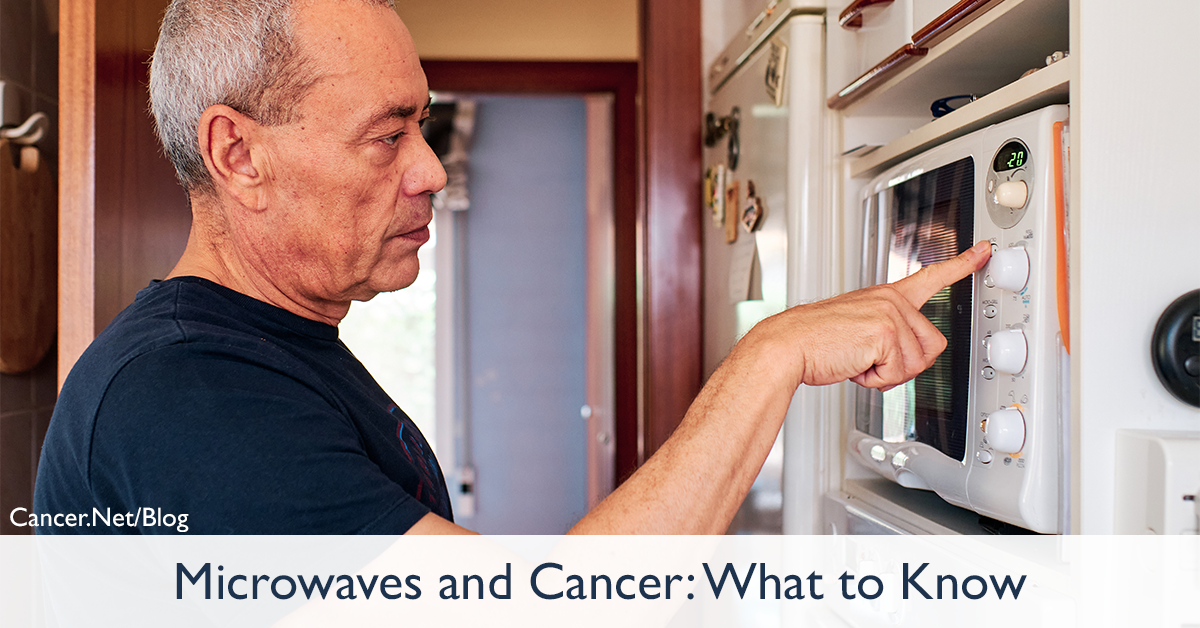
Microwave ovens serve up easy convenience. In just a few short minutes, a bag of kernels can transform into an orb of hot popcorn or a frozen dinner can become a multi-course meal.
But what if you stand in front of the microwave to watch that bag of popcorn or plate of leftovers cook? Does it matter how close you stand? Is there any possibility that the microwave’s radiation could cause cancer?
It is a long-held misconception that using a microwave can lead to cancer. Here, we discuss how microwaves work, how they’re regulated, why they’re extremely unlikely to emit radiation, and how you can operate this machine safely to reduce risks for you and your family.
How do microwaves work?
Microwave ovens convert electricity into a type of low-frequency electromagnetic radiation called microwaves. Imagine electromagnetic radiation as a spectrum of energy with radio waves and microwaves on the low end and gamma rays and x-rays on the high end. For example, radiation therapy for cancer treatment uses x-rays to kill cancer cells and shrink tumors because x-rays have more energy and can therefore penetrate deeper into the body.
A magnetron, or high-powered vacuum tube inside the microwave oven, creates the microwaves, and the metal walls inside the microwave constantly bounce these waves around. Microwaves heat up food by making the water molecules inside your food vibrate. Sometimes, a rotating plate inside the oven ensures all parts of the food get equally hit by the waves to heat up the food more evenly.
Why doesn’t radiation get out of the microwave?
Radiation stays inside the microwave as long as the doors are closed. In fact, microwaves are built to only work when the doors are closed. Plus, to ensure the safety of microwaves, the U.S. Food and Drug Administration (FDA) regulates microwaves. It makes rules or safety standards that microwave manufacturers must follow. For example, each microwave must have at least 2 separate safety locks to stop it from working if the door opens.
Can radiation leak from a microwave?
The FDA rules also say that only a certain amount of radiation can leak from the microwave at about 2 inches away or farther. The amount is 5 milliwatts per square centimeter, which is a level of radiation that is not dangerous to people. However, there have been some rare cases of radiation exposure. Most accidents happened because microwave radiation escaped through gaps in the door or seals, according to the FDA, adding that its regulations are designed to prevent these leaks.
Standing farther away from the microwave decreases your risk of encountering any microwave radiation. This is because microwave energy decreases as you get farther away from the microwave itself. Try standing a few feet away from the microwave to reduce your risk of exposure when heating up food.
Can radiation or microwaves linger in my food?
No. Food does not retain microwaves or radiation after cooking. The World Health Organization (WHO) compares microwave ovens to how lightbulbs work. “When the lightbulb is turned off, no light remains,” according to the WHO website. Similarly, when a microwave is turned off, there is no longer radiation.
Do microwaves pose other risks?
Burns from spilling hot food and liquids are common when using a microwave. For example, a cup of water can superheat in the microwave in ways that are different than on a stove where steam can escape. Superheated water is when water goes past its boiling point yet doesn’t appear as boiling water. This is because unlike boiling water on the stove, there is nowhere for bubbles to form in a cup in the microwave. Disturbing the microwaved water by moving it or by dipping a spoon could make the water bubble and boil immediately, leading to an explosion. This, in turn, may cause severe burns.
Spills were the most common injury from microwaves during a 20-year study of emergency room visits, according to a 2013 study in the American Journal of Emergency Medicine. On average, an estimated 21 people per day were treated for microwave-related injuries, with hands and fingers being most commonly hurt.
Tips for safely using a microwave
-
Read the instruction manual that came with your microwave oven and follow its recommendations.
-
Use only microwave-safe containers made of glass, ceramic, or microwave-safe plastic.
-
Don’t use a microwave if the door does not work, if you see gaps in seals, or if there is other damage to the microwave.
-
Don’t stand right next to the microwave for extended periods of time while your food cooks.
-
Beware of superheated water and follow the microwave’s instructions for heating water. If children use the microwave, tell them about the risks of hot food and liquid burns and educate them on how to use the microwave safely.







